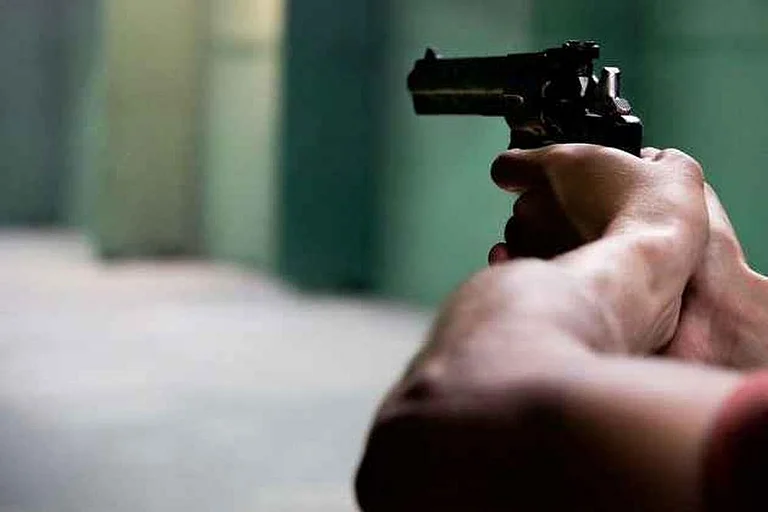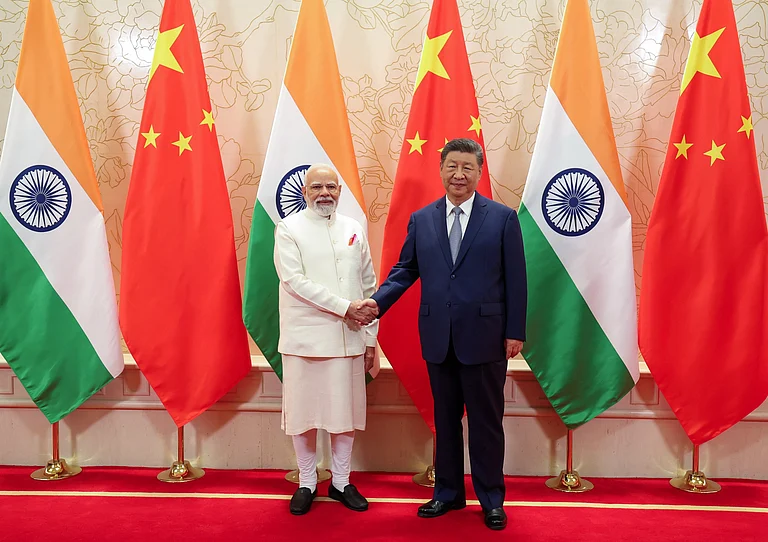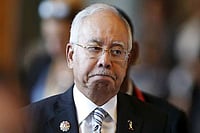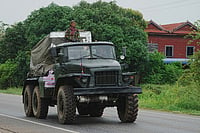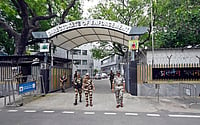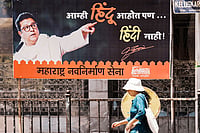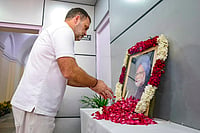My colleagues and I welcome you and send you greetings on your safe arrival in India. We shall be happy to afford the necessary facilities for you, your family and entourage to reside in India."
Excerpt from a telegram sent by Jawaharlal Nehru to the Dalai Lama on the Tibetan spiritual leaders arrival in India after his dramatic escape from Tibet in 1959
For the past 50 years, India has been blazing forth on its famed tolerance, attracting thousands of refugees from different corners every year. Victims of political, religious and ideological persecution have found sanctuary in a country proud of its heritage of plurality, reluctant to shut its doors on any shelter seeker. The sensational escapade of Ugyen Trinley Dorje, the 14-year-old Tibetan boy who trekked 900 km across frozen terrain from Tibet, hence, chimes with this perceived hospitality.
But India in 2000 is a different country from 1959. It enjoys lesser room for diplomatic niceties and has more practical concerns to consider. Barring the 1962 war, an uneasy equilibrium has existed between China and India over Tibet. The unexpected arrival on January 5 of Ugyen Trinley, the 17th Karmapa and leader of one of Tibetan Buddhisms main sects, threatens to disrupt this delicate balance and cause trouble within the Tibetan exile movement itself.
New Delhis circumspect reaction now is in sharp contrast to Nehrus effusive display of warmth in 1959. This revised stance might indicate a fear of receiving another dose of the Communist Chinese dragons breath. "China never forgave Nehru for sheltering the Dalai Lama, contributing to Chinas invasion of India three years later," explains noted historian Stanley Wolpert in Nehru, A Tryst With Destiny. Has Tibet, then, finally become Indias burden?
At first, the arrival of the Karmapa was greeted almost like the coming of a messiah and potential successor to the ageing Dalai Lama. But as questions about the boys authenticity began to be raised from within the Kagyu sect to which he belongs, it soon became apparent that the BJP-led regime was not about to seek another confrontation with China. It had outgrown its aggressive posture towards its powerful neighbour, so evident before and after Indias nuclear tests in 1998 which senior ministers publicly said were aimed at countering Beijings threat. But does New Delhi have another policy in place?
Varaprasad Sekhar of Delhis Jawaharlal Nehru University believes India needs to decide its priorities quickly. He says New Delhi should be careful of Tibet using India as a platform to promote its demand for autonomy. "Ultimately, India will have to make a choice... and politically the priority will have to be China," he says. India doesnt officially recognise the Tibetan government-in-exile although it allows the Dalai Lama to stay here as the spiritual head of the Tibetan Buddhists. Hosting the Karmapa, belonging to a sect older than the Dalai Lamas, can only make things less ambivalent.
India ducked when Chinas foreign ministry spokesman Zhu Bangzao issued a veiled threat against granting political asylum to the Karmapa. Zhu said any such move would violate the five principles "of peaceful coexistence" which form the declared basis of Sino-Indian ties. "We havent received any request for political asylum," countered external affairs minister Jaswant Singh. "We will think about it when there is one."
Chinas bottomline allows it to save face in what was an apparent lapse of security around the Tsurphu monastery from where the Karmapa escaped. At the same time it leaves a number of options open to the Indian government for a resolution of the problem:
According to The Tibetan Information Network based in London, the Karmapa was taken on two tours of China and has met President Jiang Zemin and other leaders. Less than a year ago, after a meeting in Beijing with senior Chinese officials, he was quoted by Chinas-Tibet as saying he had "received an education in patriotism" and that he would follow the instructions of Jiang and "work hard for the unification of the motherland and national unity". At the same meeting, a Chinese official was quoted as saying that the "healthy growth" and "progress" of the Karmapa "will have great impact on the development and stability of Tibet".
All this has an indirect bearing on Indias current circumspection. In fact, a Kagyu sect regent, Shamarpa Rimpoche, has directly alleged that the boy is a Chinese stooge sent by Beijing to retrieve the Black Hat, the sects central ecclesiastical icon that sits in Sikkims Rumtek monastery, and other spiritual symbols belonging to the 16th Karmapa and to undermine the support for the Dalai Lama. Shamarpa, one of the four regents responsible for identifying the Karmapa, claims that another boy based in Kalimpong, Thinley Dorje, is the real Karmapa. (Only two of the four Sikkim-based regents recognise Ugyen Trinley.)
Despite what it may believe, there are signs that India might be giving in to Chinese pressure. "When minister of state Ajit Panja says on TV that no security has been given to the Karmapa because he has only come for a black hat and musical instruments, India is just repeating what China is saying. We dont know for sure why the boy has come, so why would India?" asks a member of the Dalai Lamas Bureau.
It doesnt help that the Tibetans in Dharamshala themselves are baffled and divided over the entire issue. While the younger and more militant members of the community are clear that the Karmapa should stay back to protest the "religious suppression by the Chinese in Tibet," those sharing the government-in-exiles views advocate a cautious approach. Aware that there are different claimants for the Karmapas post, they are leaving the final decision to the Dalai Lama. "The Dalai Lama is the biggest leader of them all," they emphasise. "And he has welcomed the Karmapa."
The Dalai Lama though - conveniently, critics would say - has gone into a spiritual retreat. He will remain silent till March, when his retreat ends. All that Tibets religion and culture minister-in-exile Tashi Wangdi would say is, "It is for the Karmapa to decide where he wants to stay. We will help him in anything he chooses to do."
It is a difficult decision for the teenaged Karmapa to make. His maternal uncle Namgyal Gonpo is worried about the pressure being put on his nephew. He suggests that if the Karmapa is to stay back, he should do so on a students visa and forget political asylum. That is because Gonpo believes the Karmapa should aim at an eventual return to Tibet, at most staying back in India for education. "Otherwise the doors to his homeland will be shut to him forever," says he. "But it is not in anyones interest to let him speak or listen. They have made a puppet out of him." Not surprisingly, the Dharamshala police picked up Gonpo for interrogation. There are fears among the Tibetan community that Chinese agents might harm the Karmapa.
In an effort to stymie such moves, the Karmapa has been lodged in the secluded Gyuto monastery in Sidhbadi, about 15 km from McLeodganj. It lies in the shadow of the snow-topped Dhauladar range and has security personnel swarming its premises. But that hasnt stopped the media from focusing cameras and binoculars on the 5th floor, where the Karmapa has been lodged. Eager-beaver reporters even quiz the occasional milkman entering the monastery for information. Far from this restricted environs, a Tibetan youth sipping cider in Dharamshalas wintry sunshine observes: "Enlightenment is fine, but a kid, Lama or not, also needs some space. Surely, he can do without the governments of China, India and Tibet breathing down his neck."
Meanwhile, experts warn of the risks of making China an enemy over the issue. Says Mira Sinha Bhattacharjea, co-chairman of the Institute of Chinese Studies in Delhi: "Why stick to the 19th century concept that we must always be at loggerheads with our neighbours and that we need some sort of buffer state. If we dont change our attitude, we will just become the tools of the Americans." She refutes any suggestion that in the present circumstances India can use the Karmapas defection to its own advantage. "That can happen only if India changes its policy towards Tibet and decides to recognise the government-in-exile," she says. Robbie Barnett, a Tibet expert at Columbia University, feels that far from using the situation as a lever, the Indian government has shown sophistication in its decision to be circumspect. "They are not shouting about human rights abuses in China, nor are they getting down on their knees in front of China," he says.
The Dalai Lamas presence in Dharamshala might be a badge of tolerance worn proudly by India, but its increasingly bringing diminishing returns. Every year, thousands of Tibetans, including Chinese spies and tourists, pour across the border into India. The Dalai Lama now encourages most of them to return to Tibet after an audience with him. "Since 1992, India has been tougher on refugees; after three months theyre usually encouraged to leave," says Barnett.
As for the Karmapa himself, in his first public statement a week after his arrival in Dharamshala, he said he was pleased that Indo-Tibetan organisations had "welcomed" him to "stay in India and preferably in Dharamshala". A decision not to go to Sikkim immediately would only be to his advantage as it might trigger group clashes in Rumtek monastery, his ultimate destination, again. But his stay in India promises to be a lonely one for a while. The Sherbaling monastery, which is being prepared for his "imminent shifting", is even further removed from the outside world. Another venue being considered is the remote Bodh temple in the Kullu hills.
While the Lamas plan for the Karmapas long stay in India, the ministry of external affairs is seeking to gloss over the quandary it finds itself in. "We have hosted the Dalai Lama for so many years, so why should we have a problem with this young boy? Of course we will welcome him too," says an mea officer. He says the government has never considered the boy to be anything but a Tibetan refugee. "We have never called him the Karmapa, have we?" However, analysts say that under no circumstance can the Karmapa be termed an ordinary refugee. "There is a huge difference between the Karmapa and an ordinary Tibetan. The moment we let him stay we recognise the entire community that he represents," says Sekhar.
This has prompted suggestions from some quarters that the Karmapa be encouraged to find asylum in a western country where his brand of Buddhism is popular and spare India the blushes. Again, Dharamshala, already bursting at the seams, has scarcely any more room for his followers. His followers, however, say that India is the logical choice not merely because it is geographically close to Tibet. "He has come for lessons from his teachers. Although the Kagyu sect is popular abroad, there is no guarantee those places will have good teachers. The best teacher, of course, is the Dalai Lama," says a member of the Dalai Lamas Bureau in Delhi. Ravi Nair, head of the South Asian Human Rights Documentation Centre, explains: "India is the first country of asylum for many Tibetans, just as the United States is for the Cubans. So why should the Tibetans go elsewhere? It makes no sense."
For its part, the US has been at pains to explain special coordinator for Tibet Julia Tafts visit to Dharamshala in the wake of the Karmapas arrival. American officials emphasise that her trip to India had been in the pipeline for five months and her mission was mainly to visit Bhutanese refugee camps in Nepal. According to them, she made a trip to Dharamshala because she had been granted an audience with the Dalai Lama.
Whatever the reasons, the US, like India, is taking its own time to assess the situation. The only ones who seem to be in a hurry are the Chinese. In all likelihood, a studied ambiguity will continue to be the approach on all fronts.








